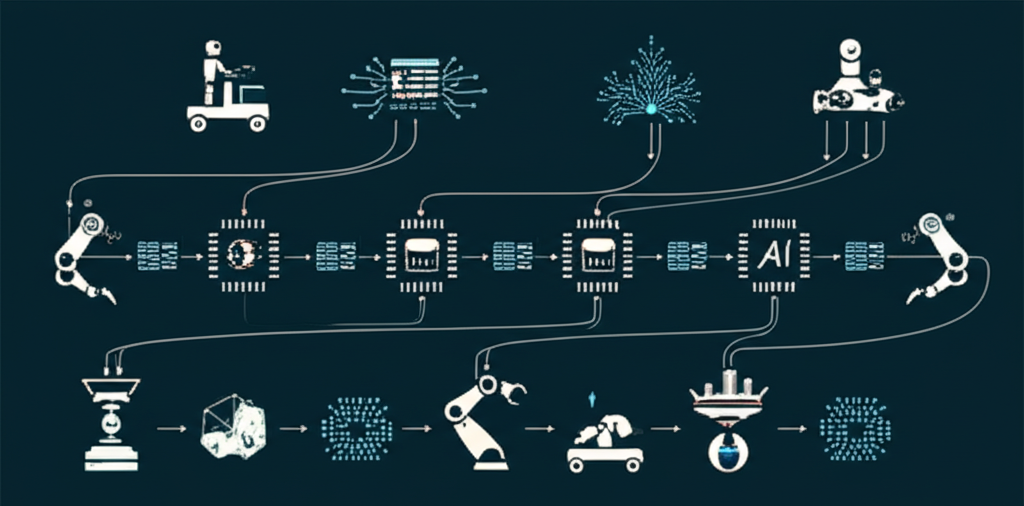Technical Architecture
Detailed explanation of MechaMesh's technical architecture and components
Table of Contents
1. System Overview

The MechaMesh platform is built on a multi-layered architecture that integrates blockchain technology, robotics, and artificial intelligence to create a decentralized ecosystem for robot coordination and services. The architecture consists of the following core layers:
Blockchain Layer
Built on Ethereum for Security and decentralization and low transaction, providing the foundation for decentralized identity, payments, and smart contracts.
Robot Registry Layer
Provides on-chain identity and verification for robots, enabling secure authentication and authorization within the ecosystem.
Swarm Intelligence Layer
Enables decentralized AI coordination between robots, allowing for collaborative learning and task optimization.
Marketplace Layer
Facilitates the discovery, negotiation, and execution of robot services, with built-in payment processing and reputation systems.
These layers interact through a series of well-defined APIs and protocols, creating a cohesive ecosystem that enables secure, efficient, and decentralized robot operations. The architecture is designed to be modular, allowing for independent evolution of each layer while maintaining compatibility across the platform.
Key Technical Decisions
- Ethereum blockchain for for security and decetralization
- NFT-based robot identity for secure, verifiable robot registration
- Decentralized federated learning for swarm intelligence
- Zero-knowledge proofs for privacy-preserving verification
- Microservices architecture for scalability and maintainability
2. Blockchain Layer

The blockchain layer serves as the foundation of the MechaMesh platform, providing a secure, decentralized infrastructure for transactions, identity, and smart contracts. MechaMesh leverages the Ethereum blockchain for security and decetralization,and robust smart contract capabilities.
2.1 Ethereum Integration
MechaMesh integrates with Ethereum through a combination of on-chain programs (smart contracts) and off-chain services that interact with the blockchain. The platform utilizes Solana's Program Derived Addresses (PDAs) to create deterministic addresses for robot identities, marketplace listings, and other on-chain data.
Smart Contract Architecture
MechaMesh's smart contracts are organized into the following modules:
- Registry Program: Manages robot identity and verification
- Marketplace Program: Handles service listings, matching, and payments
- Governance Program: Facilitates DAO-based decision making
- Staking Program: Manages token staking and rewards
- Insurance Program: Handles risk pooling and claims processing
2.2 Transaction Flow
Transactions in MechaMesh follow a consistent pattern:
This transaction flow ensures that all operations on the MechaMesh platform are secure, transparent, and immutable, providing a trustless foundation for robot coordination and services.
Technical Specifications
- Transaction Throughput: Up to 65,000 TPS
- Block Time: ~400ms
- Transaction Cost: ~0.000005 SOL per transaction
- Smart Contract Language: Rust
- Consensus Mechanism: Proof of History (PoH) + Proof of Stake (PoS)
3. Robot Registry & Identity

The Robot Registry and Identity layer provides a secure, verifiable system for robot registration, authentication, and authorization within the MechaMesh ecosystem. This layer ensures that only verified robots can participate in the marketplace and swarm intelligence network.
3.1 On-Chain Identity
Each robot in the MechaMesh ecosystem is represented by a unique Non-Fungible Token (NFT) that serves as its on-chain identity. This NFT contains essential information about the robot, including:
Identity Attributes
- Unique identifier (UUID)
- Manufacturer information
- Model and serial number
- Hardware specifications
- Capability profile
- Firmware version
Verification Status
- Verification level (Standard, Enhanced, Professional)
- Verification timestamp
- Verifier identity
- Verification proofs
- Compliance certifications
- Security audits
3.2 Verification Protocol
MechaMesh implements a multi-level verification protocol to ensure the authenticity and security of robots in the ecosystem:
Verification Levels
Standard Verification
Basic verification of robot identity through manufacturer attestation and cryptographic signatures. Requires proof of ownership and basic security checks.
Enhanced Verification
Additional verification through hardware attestation, firmware validation, and capability testing. Includes vulnerability assessment and security hardening recommendations.
Professional Verification
Comprehensive verification through physical inspection, advanced security auditing, and performance benchmarking. Includes ongoing monitoring and compliance certification.
3.3 Cryptographic Security
Robot identity is secured through a combination of cryptographic techniques:
- Ed25519 Key Pairs: Each robot generates a unique cryptographic key pair that serves as its digital signature.
- Hardware Security Module (HSM): Professional-grade robots utilize HSMs to securely store private keys and perform cryptographic operations.
- Challenge-Response Authentication: Robots prove their identity through cryptographic challenge-response protocols.
- Zero-Knowledge Proofs: Used for privacy-preserving verification of robot capabilities and compliance.
Implementation Details
The Robot Registry is implemented as a Solana program with the following key functions:
// Robot registration function
pub fn register_robot(ctx: Context<RegisterRobot>, robot_metadata: RobotMetadata, signature: [u8; 64]) -> Result<()> {
// Verify manufacturer signature
verify_manufacturer_signature(&robot_metadata, &signature)?;
// Create robot NFT
create_robot_nft(ctx, &robot_metadata)?;
// Initialize verification status
initialize_verification_status(ctx, VerificationLevel::Standard)?;
// Emit registration event
emit!(RobotRegisteredEvent {
robot_id: robot_metadata.uuid,
owner: *ctx.accounts.owner.key,
timestamp: Clock::get()?.unix_timestamp,
});
Ok(())
}
4. Swarm Intelligence
This section details the swarm intelligence architecture...
5. Marketplace Architecture
This section details the marketplace architecture...
6. Security Architecture
This section details the security architecture...
7. Data Flow & Processing
This section details the data flow and processing architecture...
8. API Documentation
This section provides API documentation...
9. Integration Points
This section details integration points...
10. Scalability & Performance
This section details scalability and performance considerations...